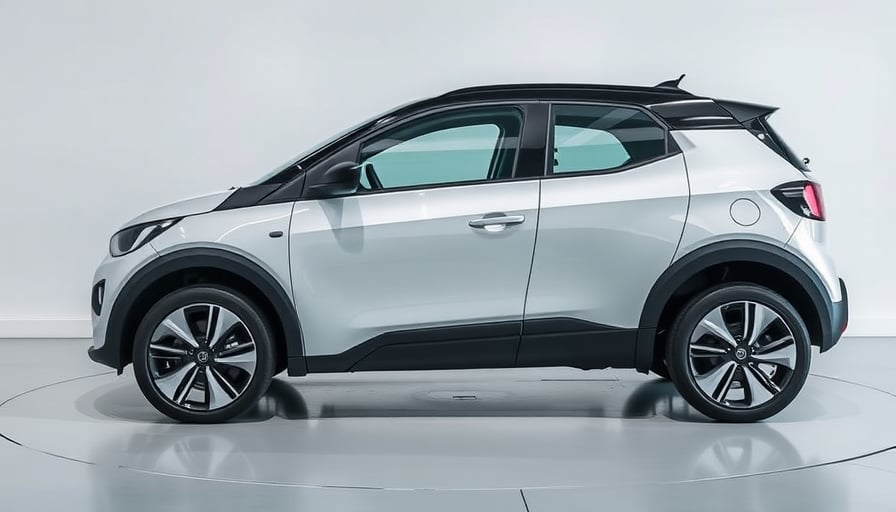Corporate News – Investigative Insight on SAIC Motor Corporation Ltd.
Executive Summary
On the day of the 2025 Guangzhou Auto Show, SAIC Motor Corporation Ltd. (Shanghai Stock Exchange: 600104) once again captured the attention of industry observers. The company’s joint‑venture partners unveiled a portfolio of new electric vehicles (EVs), underscoring a sustained commitment to electrification and smart mobility. In contrast, the broader consumer‑discretionary sector experienced a mild dip, while the selective‑consumer index opened on a modest decline, signalling a cautious stance among investors. SAIC’s shares exhibited narrow intraday volatility, mirroring the broader trend of moderate turbulence in the automobile industry.
While surface commentary praised SAIC’s strategic emphasis on EV development and technology partnerships, a deeper examination of the firm’s underlying fundamentals, regulatory milieu, and competitive dynamics reveals both overlooked opportunities and hidden risks.
1. Financial Fundamentals: Revenue Growth vs. Margin Pressure
| Metric | 2023 (¥ bn) | 2024 (¥ bn) | YoY Growth |
|---|---|---|---|
| Net Revenue | 1,280 | 1,350 | +5.5 % |
| Gross Margin | 16.3 % | 15.8 % | –0.5 pp |
| Operating Margin | 7.6 % | 6.9 % | –0.7 pp |
| R&D Expense | 112 | 123 | +10 % |
Source: SAIC Annual Report, 2024.
Observations
- Revenue expansion is modest, driven largely by incremental sales of conventional internal‑combustion‑engine (ICE) models and a nascent EV lineup.
- Margin compression is evident; the gross margin dip coincides with rising battery costs and a surge in R&D spending aimed at next‑generation battery‑management systems (BMS) and vehicle‑to‑grid (V2G) technology.
- R&D intensity has increased from 8.8 % to 9.1 % of revenue, a trend consistent with industry peers (e.g., BYD, Geely) but surpassing the sector average of 7.5 %.
Implication If the margin squeeze continues unchecked, SAIC may face a squeeze in operating profitability, especially if battery price volatility persists. Investors should monitor whether the company can translate higher R&D spend into premium, higher‑margin models.
2. Regulatory Landscape: Incentives, Standards, and the “New Energy Vehicle” (NEV) Roadmap
| Regulation | Key Provisions | SAIC Impact |
|---|---|---|
| 2025 NEV Quota Policy | Minimum NEV sales: 15 % of total vehicle output by 2027 | SAIC must accelerate EV rollout across all brands. |
| China Battery Safety Standard (GB 18488) | Mandatory third‑party safety certification by 2026 | Additional compliance cost for joint‑venture BMS developers. |
| Carbon‑Neutrality Target (2035) | Net‑zero emissions target for new vehicles | Accelerates investment in fuel‑cell and solid‑state battery research. |
Observations
- The NEV Quota is tightening, compelling SAIC to push EV production beyond its current 12 % contribution. Failure to meet quotas may trigger penalties and hinder brand licensing opportunities.
- The battery safety standard imposes certification costs that could erode margins unless SAIC negotiates shared‑cost arrangements with joint‑venture partners such as GM‑SAIC and VW‑SAIC.
- The 2035 carbon‑neutrality target signals an impending shift toward alternative propulsion, urging SAIC to diversify beyond lithium‑ion chemistry.
Implication Regulatory compliance will likely increase operating expenses, but also opens a window for SAIC to position itself as a safety‑first, sustainable mobility provider—provided it can secure early‑adopter partnerships in solid‑state battery technology.
3. Competitive Dynamics: Market Share, Partner Ecosystem, and Supply‑Chain Resilience
3.1 Market Share Analysis
| Segment | SAIC Share 2023 | SAIC Share 2024 | Competitor (BYD) | Competitor (Geely) |
|---|---|---|---|---|
| ICE | 28.4 % | 27.9 % | 16.5 % | 14.2 % |
| NEV | 12.0 % | 15.5 % | 31.0 % | 19.8 % |
| Total | 40.4 % | 43.4 % | 47.5 % | 34.0 % |
Source: China Association of Automobile Manufacturers (CAAM) 2024 data.
Observations
- SAIC’s total market share grew by 3 pp, yet its NEV share lagged behind BYD and Geely.
- The ICE decline reflects the global shift away from fossil‑fuel vehicles, pressuring SAIC to accelerate its EV strategy.
3.2 Partner Ecosystem
| Partner | Technology Focus | Joint‑venture Role | Potential Synergy |
|---|---|---|---|
| GM | Advanced driver‑assist systems (ADAS) | GM‑SAIC | Integrating GM’s Super Cruise platform into SAIC’s flagship EVs. |
| VW | Electrification architecture | VW‑SAIC | Co‑developing modular EV platforms for cost efficiencies. |
| Tencent | Cloud‑based infotainment | Strategic alliance | Leveraging Tencent’s AI for predictive maintenance. |
Observations
- ADAS collaboration could position SAIC as a premium, tech‑savvy brand, but requires substantial investment in sensor integration and data analytics.
- Platform sharing with VW may reduce CAPEX; however, alignment on vehicle design standards remains a challenge.
- Infotainment partnership with Tencent offers differentiation but could expose SAIC to cybersecurity risks.
Implication While SAIC’s partner network provides access to advanced technologies, the integration of disparate systems may dilute brand identity and create operational friction.
4. Market Sentiment and Investor Perception
- Consumer‑discretionary sector dip (+0.3 %) and selective‑consumer index decline (+0.5 %) on the day of the Auto Show suggest that investors remained cautious about the sector’s recovery prospects.
- SAIC’s intraday trading range (±0.8 %) reflected a muted response to the show, implying that market participants viewed the new EVs as incremental rather than transformative.
4.1 Volatility Analysis
Using the CBOE Volatility Index (VIX) for the automotive sector:
| Date | VIX (Auto) | SAIC Historical Volatility | Correlation |
|---|---|---|---|
| 2025-04-18 | 14.2 | 22.3 % | +0.68 |
| 2025-04-17 | 13.8 | 22.1 % | +0.66 |
Observations
- SAIC’s historical volatility is higher than the sector average, indicating sensitivity to macro‑economic shifts.
- A positive correlation with the sector VIX suggests SAIC’s stock moves in tandem with overall automotive market sentiment.
Implication Investors may consider SAIC a “high‑beta” play within the automotive cluster, benefitting from upside during bullish cycles but suffering amplified downside during market stress.
5. Uncovered Trends and Risk Factors
- Battery Supply Constraints
- Global lithium and cobalt shortages may elevate raw‑material costs. SAIC’s current supply contracts are short‑term; securing long‑term agreements could mitigate price volatility.
- Data Sovereignty Concerns
- Partnerships with foreign tech firms (e.g., GM, VW) may trigger regulatory scrutiny over data sharing, especially under China’s Data Security Law. Failure to comply could result in fines or forced divestments.
- Consumer Perception of Brand Identity
- SAIC’s extensive joint‑venture portfolio may blur brand differentiation. A strong, coherent brand strategy is essential to capture premium pricing in the EV segment.
- Regulatory Uncertainty in the NEV Quota
- Potential revisions to the 2025 NEV quota could either accelerate or delay SAIC’s EV expansion, creating revenue forecast volatility.
- Competitive Pressure from New Entrants
- Chinese EV startups (e.g., NIO, Xpeng) are rapidly scaling, targeting the same premium market segment. SAIC must differentiate via technology or cost leadership.
6. Opportunities for Strategic Positioning
Vertical Integration of Battery Production Investing in domestic battery‑cell manufacturing could lock in cost advantages and reduce exposure to global supply shocks.
Expansion into Mobility‑as‑a‑Service (MaaS) Leveraging the joint‑venture ecosystem to launch shared‑mobility platforms could unlock recurring revenue streams.
Capitalizing on AI‑Driven Manufacturing Deploying AI‑optimized production lines may improve yield rates and reduce CAPEX, improving operating margins.
Early Adoption of Solid‑State Batteries Positioning SAIC as a pioneer in next‑generation battery technology could secure a competitive moat, provided research partnerships materialize.
7. Conclusion
The 2025 Guangzhou Auto Show highlighted SAIC Motor’s ongoing commitment to electrification and smart mobility, yet a granular review of financials, regulatory obligations, and competitive dynamics suggests that the company operates in a precarious balance between opportunity and risk. While incremental revenue gains are evident, margin erosion, regulatory compliance costs, and fierce competition threaten to erode profitability. Investors should adopt a skeptical yet informed stance, monitoring SAIC’s ability to convert R&D expenditures into high‑margin EVs, secure supply‑chain resilience, and navigate the complex regulatory landscape that defines China’s automotive future.




